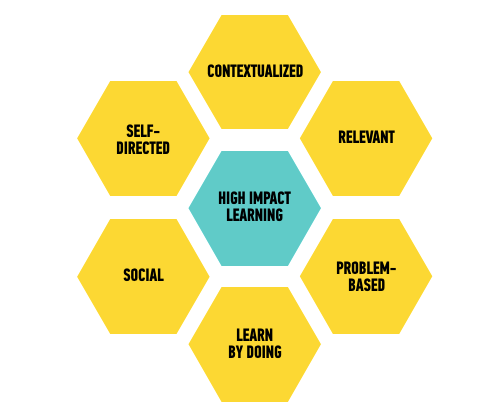Everyone knows what a quality learning experience feels like: exciting, energizing, satisfying, and entertaining. Conversely, everyone knows what a bad learning experience feels like:bored, useless, disappointing or unsatisfying.
So how do you create experiences that inspire the first set of words and avoid the second? Based on our experiences designing high impact learning experiences for adults, we’ve identified four universal truths that apply to almost all of our engagements.
Adult learners learn best when��
- we know why we��re learning something and can place it in the context of a larger goal or need.
- our past experience is appreciated, and we aren��t being asked to waste time learning things we already know.
- the experience is interactive and fun �C a kind of ��edutainment��.
- the learning is related to a specific goal or outcome that we are trying to achieve
In order to hit each of these themes, 足球竞彩网 Assembly established a honeycomb framework of 6 key principles to help guide the creation of our learning experiences.

1. Contextualized
It��s important that any learning experience be put into its proper context, preferably at the beginning of the program. You might call this ��seeing the bigger picture.�� Students should know what the ultimate goal of the education is; they should be able to see, in detail, how each lesson helps them toward that goal. For broader organizational transformation, it’s worth enlisting help from marketing and communications partners to create a story around why this program matters.
2. Relevant
Employees are most interested in learning subjects that have immediate relevance to their work and/or personal lives. They want knowledge or skills that can be immediately applied, and that will be useful for years to come. Remember how you annoyed your high school calculus teacher by continually asking ��When am I ever going to use this subject again?�� That impulse does not go away when you��re an adult. Relevance is also a matter of not wasting time by going over knowledge that��s redundant. A class full of people trying to learn advanced JavaScript doesn��t need to start with a lesson on how to send an email in Outlook. Keep your training programs relevant by ensuring that audience and content are as aligned as possible.
3. Problem-Based
Whenever possible, it��s best to structure learning around a real scenario that the students might encounter. Students essentially teach themselves; they become ��producers�� of knowledge, rather than ��consumers.�� We picked up this technique, in part, through our partnership with GE. They famously incorporate outdoor orienteering into their leadership development programs. Classes are broken into teams and challenged to direct themselves through wooded areas with the aid of a map and compass. We know that getting lost in the woods isn��t quite a ��real�� situation that an office worker would encounter in their professional life. But successful orienteering requires you to clearly articulate a plan, leverage tools, and make decisions to guide a team to their ultimate goal �Cskills that are relevant to countless business scenarios.
4. Learn By Doing
As with the previous principle, we find that students taking an active role rather than passive role makes for a higher quality learning experience. In other words, the best way to learn a skill is to actually practice that skill. 足球竞彩网 Assembly��s immersive web design class, for example, doesn��t ask students to take a test for their final exam. It asks them to build their own website. We want to break down the barrier between demonstrating competency ��in the classroom�� and ��in the real world.��
5. Social
足球竞彩网 Assembly started as a learning community �C a group of enthusiastic people coming together to add to their skillsets, network with like-minded professionals, and socialize. That social focus is baked into our company DNA, and we��re still strong proponents of the approach. Going through an educational program as part of a group not only means more support, more engagement, and more fun; it can also, in some cases, accelerate the pace of learning. The allure and benefits of social learning can be seen in the rise of Slack, the wildly popular workplace messaging app. Slack (and a slew of competitors) makes it easier for desk-bound office workers to collaborate and feel a sense of community. While some skeptics criticize Slack for inspiring what they see as an excessive amount of goofing around, fans insist that the gains in productivity far outweigh any distraction that comes with an increase in idle chatter. GA advocates for as much social activity in training programs as possible with group-oriented games, discussions, and breakout exercises.
6. Self-Directed
This last principle is arguably the most important aspect of a high impact learning experiences: empowering adults to feel like they��re setting their own direction. An educational program that��s truly self-directed will allow students to choose what and how much to learn and know. The language learning app Duolingo is a good example of this approach. Users are invited to work at their own pace, and can pick and choose which lessons they want to work on. If they don��t feel like brushing up on their prepositions that day, they can choose to learn animal nouns instead. The flexibility and customizability helps to make the content engaging and memorable.
By starting with an intended outcome and identifying your audience and the problems that they would most like to have solved, you��ll ensure that your training content aligns well with your teams. Designing an educational experience with these six principles in mind makes it much more likely that your end product will be an effective and valuable endeavor.
Interested in learning more about how to execute results-driven corporate training programs?
Explore GA’s Corporate Training Services
